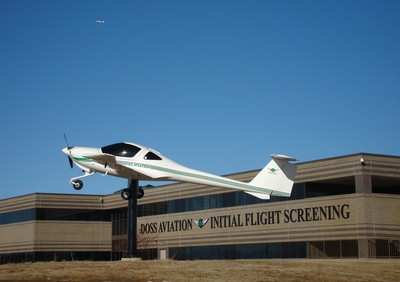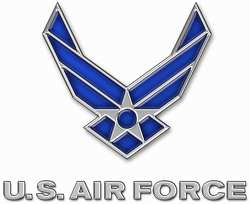Helped By Local Sales Tax, Doss Aviation Program Began February
2007
The Pueblo City Council saw the opportunity and seized it.
Paying some $13 million from a half-cent sales tax for economic
development, they brought Doss Aviation to Pueblo, CO, to take
advantage of the Air Force's consolidation of its initial flight
training.

Doss used the money to complete a $15 million renovation,
building a state-of-the-art school and "the largest hotel" in the
city, according to the Pueblo Chieftain. Doss is scheduled to pay
the city back $11 million through lease payments.
As ANN initially reported, the
209,000 square-foot facility, located on 44 acres, is adjacent to
Pueblo Memorial Airport.
Doss first estimated that roughly 1,500 students would pass
through a six-week course in Pueblo. That number could go as high
as 2,100 a year if the academy moves its screening program
there.
Right now, between 500 and 600 students are expected to pass
through the school annyally.
In two years it's possible that more than 2,000 Air Force
officers will pass through Doss Aviation's doors, a chance for
students to see if they are capable of flying more complicated
military aircraft.
The Air Force had provided its own screening program in which
potential pilots flew in light aircraft designed for acrobatic
flight. However the death of nine pilots in crashes prompted the
Air Force to rethink its program.
Initial flight training was moved to local flight schools, but
that, too, became problematic; as there was no Air Force oversight
at the local schools, students rarely, if ever, washed out of the
programs, said Lee Hall, deputy program manager for operations at
Doss.
Another factor in the Air Force's decision to return initial
flight training to Air Force oversight was the death of a daughter
of a high-ranking officer at one of the private schools.
 While Doss is the
private contractor providing the actual student training, there is,
indeed, a military presence on base. By full build-out, there will
be at least 17 Air Force officers providing oversight and a
military liaison for the lieutenants as they progress through
classes.
While Doss is the
private contractor providing the actual student training, there is,
indeed, a military presence on base. By full build-out, there will
be at least 17 Air Force officers providing oversight and a
military liaison for the lieutenants as they progress through
classes.
Training costs the military about $1 million per student, but is
imperative to ensure students can handle piloting million-dollar
military aircraft.
Since the ribbon-cutting in February, the program has the
capacity to run six different classes of students
simultaneously.
By this time next year, the school should be nearly full and
could employ up to 185 people.
Students arriving at Doss are dressed in uniform, ready to
return to military life.
Air Force Flight Commander Lt. Col. John "T.J." Tomjack provides
another reminder that when the men and women walk across the Doss
emblem cut into the floor of the facility's main entrance, they are
leaving behind civilian life.
That reminder comes at 6:30 am the next day, when most of the
students in the flight class meet Tomjack for the first time.
"You're all at attention for a reason, to reinforce that you are
part of the military again. Flying in the Air Force is not a right,
it's not an entitlement. It's a privilege. And with that privilege
come expectations and our expectation of each and every one of you
is very high."
Death is a part of military life and Tomjack's welcoming
briefing makes it clear that pilots are always at risk.
"The reason military aviators have such high expectations is
that their lives are at stake, and in this case it's your lives
that are at stake."
"Every time you strap into a plane, there is an expectation that
you are prepared mentally, physically and emotionally to do the
job."
They are all college graduates, but not all come from the US Air
Force Academy.
Doss sees students from ROTC programs from universities
throughout the country, although it doesn't really matter where
students come from, as most haven't had much flight experience.
The school provides a combination of academic work and hands-on
training.
Students are evaluated on how much they know about the airplane
the first day of training and are expected to learn everything else
quickly.
The aircraft at Doss are single-propeller, Diamond DA20 planes.
Although the engines are not that powerful, the planes are light
enough to provide an ideal training platform for the students.

"We chose Diamond aircraft for the program, because they best
met the USAF technical specification," said Frank Hunter,
President/CEO of Doss Aviation. "They combine excellent high
density altitude performance and low operating, insurance and
acquisition costs. There simply is no other proven cost-competitive
aircraft on the market."
Hall said that once the school is at its peak operation, there
will be 44 DA-20s on the Doss flight deck.
When they aren't flying, students are studying flying or
practicing in replica cockpits in a large room in the facility.
Students are scored according to Air Force standards and if anyone
in the class earns fewer than 80 points, the entire class must
retest three weeks later.
Health and fitness are serious priorities of the program,
because students are going to be expected to take the G-forces
associated with the Air Force's supersonic jets. To meet that need,
the Doss Facility provides state-of-the-art weight training
equipment, an outdoor quarter-mile track, and an indoor basketball
court.
Students are not allowed to take any over-the-counter
medications without prior approval and are expected to use common
sense when they visit town.
While Doss is the contractor for the flight school, it uses
Lesco as a subcontractor to provide the dining facility, security,
and personal trainers to help the students succeed.
But Not Everyone Succeeds
Hall said the washout rate averages between two and three
students per class, or about 10 percent.
Tomjack reminds students at the start of their six-weeks that
not everyone in the Air Force is a pilot. He likens the Air Force
to an 11-man football team.
"Pilot is just one position on the team; there are plenty of
other positions they can fill," he said.
Those who succeed in Pueblo will go on to other, more rigorous
schools before they are let loose behind some of the most powerful,
technologically-advanced machines in the world.
But on the first day, Tomjack finishes his speech to the
students by reminding them all of the work is worth it.
"The bottom line is that flying jets in the Air Force is cool.
If you're not motivated enough to behave and complete this six
weeks of training, I can assure you you're not going to be able to
carry the mail for the next year and a half."
 ANN's Daily Aero-Linx (04.13.24)
ANN's Daily Aero-Linx (04.13.24) ANN's Daily Aero-Term (04.13.24): Beyond Visual Line Of Sight (BVLOS)
ANN's Daily Aero-Term (04.13.24): Beyond Visual Line Of Sight (BVLOS) Airborne 04.09.24: SnF24!, Piper-DeltaHawk!, Fisher Update, Junkers
Airborne 04.09.24: SnF24!, Piper-DeltaHawk!, Fisher Update, Junkers Aero-News: Quote of the Day (04.14.24)
Aero-News: Quote of the Day (04.14.24) ANN's Daily Aero-Term (04.14.24): Maximum Authorized Altitude
ANN's Daily Aero-Term (04.14.24): Maximum Authorized Altitude





